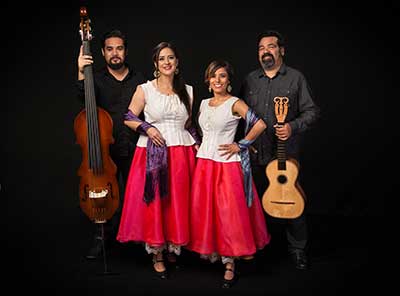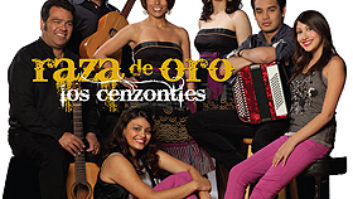
For the 23rd album release since 1995 from California-based Mexican roots music band Los Cenzontles, the four core members—Eugene Rodriguez, Emiliano Rodriguez, Lucina Rodriguez, and Fabiola Trujillo—produced a collection of traditional rancheras and corridos whose title, Alma Campirana, translates approximately to “country soul.”
“Campirana is a word that isn’t widely used, but it’s very appropriate for the style of music,” says Eugene Rodriguez, who founded the group. “It’s country soul, but when you say the word ‘country’ in English, it kind of brings up Taylor Swift and pop-country. But when you think ‘country’ in this sense, it’s not really country as a market; it’s more like a lifestyle—these little ranches in Mexico of a time that doesn’t even exist any more. The earliest songs [on the album] are from the Mexican Revolution, probably the early 1920s—I’m assuming they were written back then—and then up to the ’60s.”
Rodriguez also founded the nonprofit Los Cenzontles Mexican Arts Center and Cultural Arts Academy in San Pablo, Calif., which educates students about traditional Mexican art forms through classes and performance ensembles. “It started over 25 years ago as a youth group,” he reflects. “Then I incorporated as a nonprofit in ’94, the same year that Milo [his son, Emiliano] was born, the same year I was producing a children’s record for Los Lobos and Lalo Guerrero,” for which he received a Grammy nomination. “I decided to start the center [in its present location] in ’98. It’s been a good adventure—complex and challenging, but very rewarding.”
The band typically records its albums at the Center. However, AlmaCampirana signaled a departure from Los Cenzontles’ previous efforts with larger groups, including Shades of Brown and Regeneration. “I would say that we took more control over the sound we wanted,” says Eugene. “We had more time on this record than we typically do.”
“Usually we invite guest artists,” explains Emiliano Rodriguez, who plays bass and other instruments, and serves as Los Cenzontles’ production manager. “We’d set up here and capture everything that’s going on in the room. And that often doesn’t leave a lot of room for a creative recording style. Our jobs are less about the sound of the record and more about just getting people to work together. This was an opportunity to really pinpoint what we want from the sound of the album. We wanted to test new equipment, because we want to upgrade our studio.”
This led them to schedule studio time with veteran engineer David Luke, a frequent collaborator, at Opus Studios, a private facility in nearby Berkeley where Luke is chief engineer/studio manager. “I really like the vocal mics [at Opus],” Eugene says. “[In the studio] you can hear the quiet. Here [at the Center], we can hear the sirens, the shopping carts, the car horns, car radios, airplanes, helicopters, the rumble of motorcycles.”
Alma Campirana features traditional stringed instruments: the vihuela and guitarra de golpe (both played by Lucina), and Eugene’s 12-string guitar, as well as acoustic guitar, and upright and electric bass played by Emiliano. Their goal was to breathe new life into 20th-century songs and bring them into the present for a new audience. “This music in its element—especially historically—is dance music,” Eugene notes. “We listen to these old folk musicians with modern ears and we think they’re quaint and delicate. But they’re not. I wanted [the instruments] to feel big, bright and warm. Milo and Lucina developed a really fantastic groove that I’m very proud of.”
Luke made use of the studio’s layout and premium mics and outboard gear. “For part of the tracking Eugene was in the control room with me; we just wanted more isolation,” he says. “[Trujillo and Lucina Rodriguez] usually always sing together so they were in the booth together. I was wearing headphones, and Emiliano was in the studio, just so we had control. If they wanted to redo a part, we didn’t have the leakage factor. They wanted the option to be able to redo parts. There was some overdubbing done but not too much. Most of it was captured live to Pro Tools.”
Eugene considers the sound of Emiliano’s basses—an Eminence Portable Upright Bass and electric Rickenbacker bass—to be foundational to the music and the album as a whole. “I think he did a tremendous job at finding a bass sound,” Eugene says. “Most of the songs were recorded with a Rickenbacker. But even Ry [Cooder] assumed that it was an acoustic bass because of the quality of the sound that came out. Milo had this whole chain that he plugged his bass into to get that sound.”
“He had compressors and EQ in his effects chain, so I recorded that separately,” Luke says. His bass recording options included an Éclair Evil Twin Tube Direct Box into a Manley Massive Passive EQ and Purple Audio MC77 Limiter (an 1176 clone); the effects pedals through a Radial JDI into a Vintech Audio X73i preamp; and a Victoria bass amp and Randall isolation cabinets housing 10-inch Eden Bass speakers, inside a back room.
“The 12-string had a KM 184 mic on the bridge,” Luke says. “And then around the 12th fret, pointing toward the hole, was a Royer 121. Being a figure-8, it rejects the squeaks from the fret board. Both of those went through the Vintechs. I did a little EQ with the Vintechs, and then to a Focusrite Red compressor [applying] light compression.” Acoustic guitar, vihuela and guitarra de golpe each took a DPA 4011 and Coles 4038 through Grace Design preamps, Manley Massive Passive and dbx 160.
Luke says that vocalists Fabiola and Lucina “have distinctly different voices, but the way they blend together, they really complement each other, because Fabi has a softer voice and Lucina has the edgier voice. For both of them we used the UA LA-610 preamp. Fabi was on the 251, and then the 610 fed an LA-2A, no EQ and straight to Pro Tools. And for Lucina we used the U 47, and that went from the UA 610 to the Phoenix compressor and straight to Pro Tools.” Eugene also sang into a U 47. “I try not to use EQ when I record vocals,” Luke adds. “It’s easier to fix it later.”
“When we ended up handing the tracks to [mix engineer] Greg [Morgenstein], I felt like the tracks already had an identity attached to them—more so than on previous recordings,” Eugene says. “I think ultimately we were going for that lo-fi compressed sound, as Ry [Cooder] called it. I think it was the correct choice.”
Morgenstein is another longtime collaborator with Los Cenzontles, and once again mixed their album at Enormous Studios in Los Angeles. “Maintaining the quality of those instruments is really the trick,” Morgenstein says. “On this album I didn’t need a lot of compression. I use a Fairchild 670 and a bunch of Pultecs for warming everything up. I use Avedis EQs to bring out the air and the presence. I use a few UAD plug-ins, as well, for color. I try to use as much analog gear as I possibly can. I mixed it all in Pro Tools.” Reuben Cohen at Gavin Lurssen Mastering mastered Alma Campirana.
Los Cenzontles returned to Opus Studios in December 2015 to begin working on another album project. “Yes, we are back at Opus,” Eugene acknowledges. “We were so pleased by the ‘vintage’ sound we achieved for Alma Campirana that we wanted to take a similar approach with added instrumentation, including drums. So, we are doing an album of rock covers using Mexican instruments mixed with drums and more. A great deal of fun.
“Honestly, I thought the Alma Campirana record would be of most interest to Spanish-speaking people from Mexico,” Eugene says, “more so than some of the other fusion records that we’ve done. My hope would be that everybody could appreciate this. I think it has a nice feeling to it. Actually, there’s such a gulf between the Mexican world and the non-Mexican world. Sometimes it can be a little discouraging, but it’s also an opportunity. We’re here to help everyone in. We’re all connected.”







